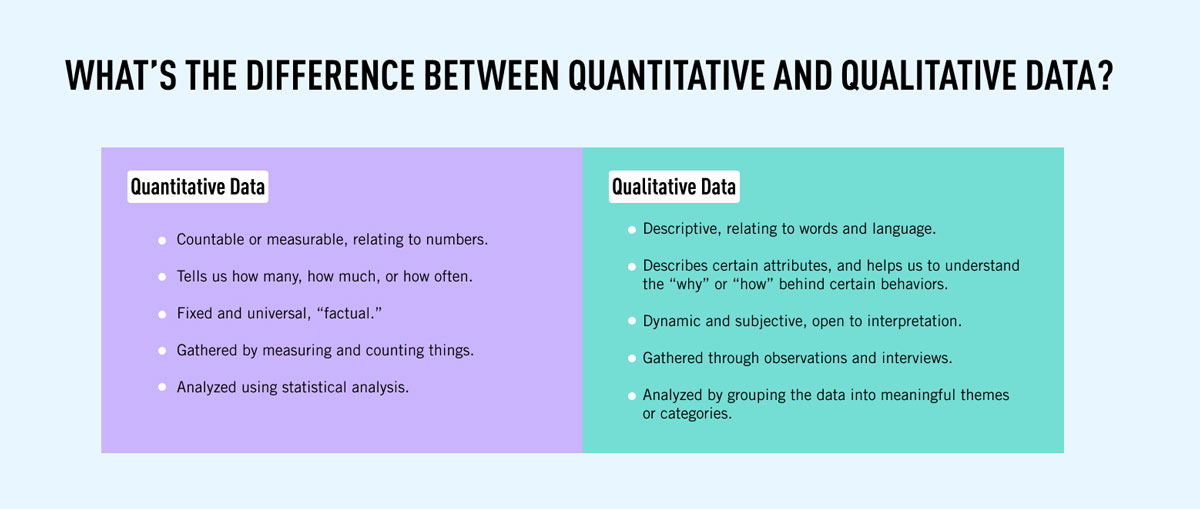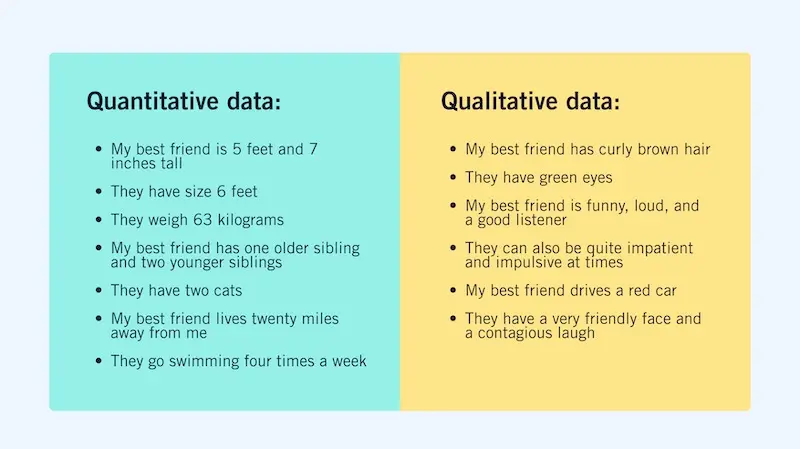If you’re considering a career in data—or in any kind of research field, like psychology—you’ll need to get to grips with two types of data: Quantitative and qualitative.
Quantitative data is anything that can be counted or measured; it refers to numerical data. Qualitative data is descriptive, referring to things that can be observed but not measured—such as colors or emotions.
In this post, we’ll define both quantitative and qualitative data in more detail. We’ll then explore all the key ways in which they differ—from how they are collected and analyzed, to the advantages and disadvantages of each. We’ll also include useful examples throughout.
By the end, you’ll have a clear understanding of the difference between qualitative and quantitative data, and a good idea of when to use which. Want to skip ahead to a specific section? Just use this clickable menu:
- Quantitative vs qualitative data: What are they, and what’s the difference between them?
- What are the different types of quantitative and qualitative data?
- How are quantitative and qualitative data collected?
- Quantitative vs qualitative data: Methods of analysis
- What are the advantages and disadvantages of quantitative vs qualitative data?
- When should I use qualitative or quantitative data?
- Quantitative vs. qualitative data: FAQ
- Key takeaways
Without further ado, let’s jump in.
1. What is the difference between quantitative and qualitative data?
When it comes to conducting research and data analysis, you’ll work with two types of data: quantitative and qualitative. Each requires different collection and analysis methods, so it’s important to understand the difference between the two.

What is quantitative data?
Quantitative data refers to any information that can be quantified. If it can be counted or measured, and given a numerical value, it’s quantitative data. Quantitative data can tell you “how many,” “how much,” or “how often”—for example, how many people attended last week’s webinar? How much revenue did the company make in 2019? How often does a certain customer group use online banking?
To analyze and make sense of quantitative data, you’ll conduct statistical analyses.
Learn more: What is quantitative data? A complete introduction
What is qualitative data?
Unlike quantitative data, qualitative data cannot be measured or counted. It’s descriptive, expressed in terms of language rather than numerical values.
Researchers will often turn to qualitative data to answer “Why?” or “How?” questions. For example, if your quantitative data tells you that a certain website visitor abandoned their shopping cart three times in one week, you’d probably want to investigate why—and this might involve collecting some form of qualitative data from the user. Perhaps you want to know how a user feels about a particular product; again, qualitative data can provide such insights. In this case, you’re not just looking at numbers; you’re asking the user to tell you, using language, why they did something or how they feel.
Qualitative data also refers to the words or labels used to describe certain characteristics or traits—for example, describing the sky as blue or labeling a particular ice cream flavor as vanilla.
What are the main differences between quantitative and qualitative data?
The main differences between quantitative and qualitative data lie in what they tell us, how they are collected, and how they are analyzed. Let’s summarize the key differences before exploring each aspect in more detail:
- Quantitative data is countable or measurable, relating to numbers. Qualitative data is descriptive, relating to language.
- Quantitative data tells us how many, how much, or how often (e.g. “20 people signed up to our email newsletter last week”). Qualitative data can help us to understand the “why” or “how” behind certain behaviors, or it can simply describe a certain attribute—for example, “The postbox is red” or “I signed up to the email newsletter because I’m really interested in hearing about local events.”
- Quantitative data is fixed and “universal,” while qualitative data is subjective and dynamic. For example, if something weighs 20 kilograms, that can be considered an objective fact. However, two people may have very different qualitative accounts of how they experience a particular event.
- Quantitative data is gathered by measuring and counting. Qualitative data is collected by interviewing and observing.
- Quantitative data is analyzed using statistical analysis, while qualitative data is analyzed by grouping it in terms of meaningful categories or themes.
The difference between quantitative and qualitative data: An example
To illustrate the difference between quantitative and qualitative data, let’s use an example. Imagine you want to describe your best friend. What kind of data might you gather or use to paint a vivid picture?
First, you might describe their physical attributes, such as their height, their hair style and color, what size feet they have, and how much they weigh. Then you might describe some of their most prominent personality traits. On top of that, you could describe how many siblings and pets they have, where they live, and how often they go swimming (their favorite hobby).
All of that data will fall into either the quantitative or qualitative categories, as follows:
Quantitative data:
- My best friend is 5 feet and 7 inches tall
- They have size 6 feet
- They weigh 63 kilograms
- My best friend has one older sibling and two younger siblings
- They have two cats
- My best friend lives twenty miles away from me
- They go swimming four times a week
Qualitative data:
- My best friend has curly brown hair
- They have green eyes
- My best friend is funny, loud, and a good listener
- They can also be quite impatient and impulsive at times
- My best friend drives a red car
- They have a very friendly face and a contagious laugh
Of course, when working as a researcher or data analyst, you’ll be handling much more complex data than the examples we’ve given. However, our “best friend” example has hopefully made it easier for you to distinguish between quantitative and qualitative data.

2. Different types of quantitative and qualitative data
When considering the difference between quantitative and qualitative data, it helps to explore some types and examples of each. Let’s do that now, starting with quantitative data.
Types of quantitative data (with examples)
Quantitative data is either discrete or continuous:
- Discrete quantitative data takes on fixed numerical values and cannot be broken down further. An example of discrete data is when you count something, such as the number of people in a room. If you count 32 people, this is fixed and finite.
- Continuous quantitative data can be placed on a continuum and infinitely broken down into smaller units. It can take any value; for example, a piece of string can be 20.4cm in length, or the room temperature can be 30.8 degrees.
What are some real-world examples of quantitative data?
Some everyday examples of quantitative data include:
- Measurements such as height, length, and weight
- Counts, such as the number of website visitors, sales, or email sign-ups
- Calculations, such as revenue
- Projections, such as predicted sales or projected revenue increase expressed as a percentage
- Quantification of qualitative data—for example, asking customers to rate their satisfaction on a scale of 1-5 and then coming up with an overall customer satisfaction score
Types of qualitative data (with examples)
Qualitative data may be classified as nominal or ordinal:
- Nominal data is used to label or categorize certain variables without giving them any type of quantitative value. For example, if you were collecting data about your target audience, you might want to know where they live. Are they based in the UK, the USA, Asia, or Australia? Each of these geographical classifications count as nominal data. Another simple example could be the use of labels like “blue,” “brown,” and “green” to describe eye color.
- Ordinal data is when the categories used to classify your qualitative data fall into a natural order or hierarchy. For example, if you wanted to explore customer satisfaction, you might ask each customer to select whether their experience with your product was “poor,” “satisfactory,” “good,” or “outstanding.” It’s clear that “outstanding” is better than “poor,” but there’s no way of measuring or quantifying the “distance” between the two categories.
Nominal and ordinal data tends to come up within the context of conducting questionnaires and surveys. However, qualitative data is not just limited to labels and categories; it also includes unstructured data such as what people say in an interview, what they write in a product review, or what they post on social media.
What are some real-world examples of qualitative data?
Some examples of qualitative data include:
- Interview transcripts or audio recordings
- The text included in an email or social media post
- Product reviews and customer testimonials
- Observations and descriptions; e.g. “I noticed that the teacher was wearing a red jumper.”
- Labels and categories used in surveys and questionnaires, e.g. selecting whether you are satisfied, dissatisfied, or indifferent to a particular product or service.
3. How are quantitative and qualitative data collected?
One of the key differences between quantitative and qualitative data is in how they are collected or generated.
How is quantitative data generated?
Quantitative data is generated by measuring or counting certain entities, or by performing calculations. Some common quantitative data collection methods include:
- Surveys and questionnaires: This is an especially useful method for gathering large quantities of data. If you wanted to gather quantitative data on employee satisfaction, you might send out a survey asking them to rate various aspects of the organization on a scale of 1-10.
- Analytics tools: Data analysts and data scientists use specialist tools to gather quantitative data from various sources. For example, Google Analytics gathers data in real-time, allowing you to see, at a glance, all the most important metrics for your website—such as traffic, number of page views, and average session length.
- Environmental sensors: A sensor is a device which detects changes in the surrounding environment and sends this information to another electronic device, usually a computer. This information is converted into numbers, providing a continuous stream of quantitative data.
- Manipulation of pre-existing quantitative data: Researchers and analysts will also generate new quantitative data by performing statistical analyses or calculations on existing data. For example, if you have a spreadsheet containing data on the number of sales and expenditures in USD, you could generate new quantitative data by calculating the overall profit margin.
How is qualitative data generated?
Qualitative data is gathered through interviews, surveys, and observations. Let’s take a look at these methods in more detail:
- Interviews are a great way to learn how people feel about any given topic—be it their opinions on a new product or their experience using a particular service. Conducting interviews will eventually provide you with interview transcripts which can then be analyzed.
- Surveys and questionnaires are also used to gather qualitative data. If you wanted to collect demographic data about your target audience, you might ask them to complete a survey where they either select their answers from a number of different options, or write their responses as freeform text.
- Observations: You don’t necessarily have to actively engage with people in order to gather qualitative data. Analysts will also look at “naturally occurring” qualitative data, such as the feedback left in product reviews or what people say in their social media posts.

4. Quantitative vs qualitative data: methods of analysis
Another major difference between quantitative and qualitative data lies in how they are analyzed. Quantitative data is suitable for statistical analysis and mathematical calculations, while qualitative data is usually analyzed by grouping it into meaningful categories or themes.
Quantitative data analysis
How you analyze your quantitative data depends on the kind of data you’ve gathered and the insights you want to uncover. Statistical analysis can be used to identify trends in the data, to establish if there’s any kind of relationship between a set of variables (e.g. does social media spend correlate with sales), to calculate probability in order to accurately predict future outcomes, to understand how the data is distributed—and much, much more.
Some of the most popular methods used by data analysts include:
- Regression analysis
- Monte Carlo simulation
- Factor analysis
- Cohort analysis
- Cluster analysis
- Time series analysis
You’ll find a detailed explanation of these methods in our guide to the most useful data analysis techniques.
Qualitative data analysis
With qualitative data analysis, the focus is on making sense of unstructured data (such as large bodies of text). Given that qualitative data cannot be measured objectively, it is open to subjective interpretation and therefore requires a different approach to analysis.
The main method of analysis used with qualitative data is a technique known as thematic analysis. Essentially, the data is coded in order to identify recurring keywords or topics, and then, based on these codes, grouped into meaningful themes.
Another type of analysis is sentiment analysis, which seeks to classify and interpret the emotions conveyed within textual data. This allows businesses to gauge how customers feel about various aspects of the brand, product, or service, and how common these sentiments are across the entire customer base.
Traditionally, qualitative data analysis has had something of a bad reputation for being extremely time-consuming. However, nowadays the process can be largely automated, and there are plenty of tools and software out there to help you make sense of your qualitative data. To learn more about qualitative analysis and what you can do with it, check out this round-up of the most useful qualitative analysis tools on the market.
5. What are the advantages and disadvantages of quantitative vs qualitative data?
Each type of data comes with advantages and disadvantages, and it’s important to bear these in mind when conducting any kind of research or sourcing data for analysis. We’ll outline the main advantages and disadvantages of each now.
What are the advantages and disadvantages of quantitative data?
A big advantage of quantitative data is that it’s relatively quick and easy to collect, meaning you can work with large samples. At the same time, quantitative data is objective; it’s less susceptible to bias than qualitative data, which makes it easier to draw reliable and generalizable conclusions.
The main disadvantage of quantitative data is that it can lack depth and context. The numbers don’t always tell you the full story; for example, you might see that you lost 70% of your newsletter subscribers in one week, but without further investigation, you won’t know why.
What are the advantages and disadvantages of qualitative data?
Where quantitative data falls short, qualitative data shines. The biggest advantage of qualitative data is that it offers rich, in-depth insights and allows you to explore the context surrounding a given topic. Through qualitative data, you can really gauge how people feel and why they take certain actions—crucial if you’re running any kind of organization and want to understand how your target audience operates.
However, qualitative data can be harder and more time-consuming to collect, so you may find yourself working with smaller samples. Because of its subjective nature, qualitative data is also open to interpretation, so it’s important to be aware of bias when conducting qualitative analysis.
6. When should I use qualitative or quantitative data?
Put simply, whether you use qualitative or quantitative data (or a combination of both!) depends on the data analytics project you’re undertaking. Here, we’ll discuss which projects are better suited to which data.
Generally, you can use the following criteria to determine whether to go with qualitative data, quantitative data, or a mixed methods approach to collecting data for your project.
- Do you want to understand something, such as a concept, experience, or opinions? Use qualitative data.
- Do you want to confirm or test something, such as a theory or hypothesis? Use quantitative data.
- Are you taking on research? You may benefit from a mixed methods approach to data collection.
You may find that more often than not, both types of data are used in projects, in order to gain a clear overall image—integrating both the numbers side and human side of things.
6. Quantitative vs. qualitative data: FAQ
What are the main differences between qualitative and quantitative research?
Qualitative research is primarily exploratory and uses non-numerical data to understand underlying reasons, opinions, and motivations. Quantitative research, on the other hand, is numerical and seeks to measure variables and relationships through statistical analysis. Additionally, qualitative research tends to be subjective and less structured, while quantitative research is objective and more structured.
What are examples of qualitative and quantitative data?
Examples of qualitative data include open-ended survey responses, interview transcripts, and observational notes. Examples of quantitative data include numerical survey responses, test scores, and website traffic data. Qualitative data is typically subjective and descriptive, while quantitative data is objective and numerical.
7. Key takeaways
Throughout this post, we’ve defined quantitative and qualitative data and explained how they differ. What it really boils down to, in very simple terms, is that quantitative data is countable or measurable, relating to numbers, while qualitative data is descriptive, relating to language.
Understanding the difference between quantitative and qualitative data is one of the very first steps towards becoming a data expert. If you’re considering a career in data, you’ll find links to some useful articles at the end of this post. Had enough theory and want some action? Check out our list of free data analytics courses for beginners, or cut to the chase and simply sign up for a free, five-day introductory data analytics short course.

